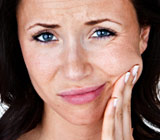 If you have pain in your jaws or related headaches, you may have Temporo-mandibular Joint Disorder, TMD. You are probably wondering what this is — and how it can be treated. If this sounds like something you may have, read on for some answers.
If you have pain in your jaws or related headaches, you may have Temporo-mandibular Joint Disorder, TMD. You are probably wondering what this is — and how it can be treated. If this sounds like something you may have, read on for some answers.
What is TMD? TMD describes a group of disorders or diseases that have the same symptoms, but may have different causes, hence it is known as “The Great Imposter.” Pain in and around the temporo-mandibular joint (TMJ), the jaw joint involved in opening and closing your mouth — is characterized by pain and soreness in the region of one or both joints, ears, jaw muscles and even the sinuses.
How does the temporo-mandibular joint work? You can feel your jaw joints working if you place your fingers in front of your ears and move your lower jaw up and down. On each side the joint is composed of an almond shaped structure at the end of the lower jaw, called the condyle, which fits neatly into a depression in the temporal bone (the bone on the side of your skull near your ear). A small disc between the two bones allows the lower jaw to move forward and sideways. The joints are stabilized by ligaments and moved by muscles, like all your joints.
What is the most common cause of TMD? Many people clench or grind their teeth as a reaction to stress. This is generally a subconscious habit, and can even occur during sleep. Continual tooth grinding habits can cause the muscles to go into spasm, which is the most common cause of TMD pain. Structures associated with the jaws — teeth, air sinuses, and even neck and back muscles — share nerves with the muscles in the joints, so the pain may be felt in those structures too, making the exact source of the pain difficult to diagnose. Symptoms of TMD may limit your ability to open your jaw and talk or eat normally.
What is the treatment for TMD? Treatment will depend on the cause, but generally the first step is to relieve pain and discomfort with heat, mild painkillers, muscle relaxants, a soft diet, and simple jaw exercises. A bite guard may be recommended, which should be custom made in our office; a rigid yet unobtrusive plastic appliance that fits over the biting surfaces of your upper teeth. Properly fitted and adjusted, it aids and causes jaw muscle relaxation by preventing clenching and grinding. It is worn during times of stress when oral habits tend to recur, and can also be worn at night.
If you are suffering from TMD — whether the pain is moderate or severe — schedule an appointment with us to have it evaluated and treated. You can learn more about TMD by reading the Dear Doctor magazine article “TMD: Understanding the Great Imposter.”



